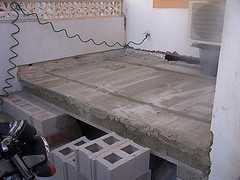 Are you considering adding on or updating that old bathroom or kitchen? As housing prices climbed, more and more families have turned to renovation instead of moving to increase their living quarters. Popular TV programs glorified the trend and contractors were kept busy round the clock.
Are you considering adding on or updating that old bathroom or kitchen? As housing prices climbed, more and more families have turned to renovation instead of moving to increase their living quarters. Popular TV programs glorified the trend and contractors were kept busy round the clock.
I know, we were one such family!
Unfortunately, a new study, found fixing up ‘This Old House’ may increase exposure to lead in young children.
The study conducted by researchers at Cincinnati Children’s Hospital Medical Center found that interior renovation of older housing is associated with a modest increase in children’s blood lead level (BLL) and associated long-term health risks.
If the house in question was built before 1978, before the federal ban on lead-based paint, tearing out walls and ceilings could expose children to lead hazards, the study concluded.
Researchers found that children living in homes built before 1978, in particular those that had been renovated had higher levels of lead in their bloodstream than children living in newer homes. In particular the researchers noted that children living in the homes during renovation, had increased exposure to lead because of the lead particles disturbed during the work. If appropriate preventative measures are not taken, lead paint dust can be spread throughout the house through heating and air conditioning ducts.
“Toxic agents such as lead could have long-term effects on children’s brain development even as early as when they are fetuses,” said Dr. Spanier. “If lead poisoning goes undetected and untreated in children, it has the potential to result in a number of neurodevelopmental issues, including ADHD and learning problems.”
To prevent or minimize children’s exposure to lead, there are a few simple measures that can be taken.
- Attach a High Efficiency Particulate Air, or HEPA, vacuum to all power tools and use a HEPA vacuum to clean up the area
- Use heavy plastic to cover doorways, windows, floors, and any furniture that can’t be removed from the renovated area and to dispose of all trash and debris
- Block off and shut off air conditioning or heating vents in the work area
- Close windows and doors in or near the work area
- Mist paint before sanding or scraping
- Keep everyone not working in the area out and, if possible, have the children stay at a friend or relatives while the work is being done
- Use personal protective devices (masks, gloves, etc)
- Seek training in lead safe work practices
- Also, if parents hire a contractor to do their home renovations, it’s important to choose someone who has gone through lead safety training.
As a parent recently involved in a renovation I carefully scanned this list of precautions and, fortunately was able to check off each one. While our son was living in the house during the renovation, fortunately the area impacted had an outside entry and…since we have individual radiant heaters in each room (not very efficient since we freeze in the winter), we didn’t have to worry about ventilation ducts spreading the lead paint dust.
Many families though have not been as lucky. If you have any concerns about the impact of your renovation on your child’s health, consult your pediatrician and ask him or her to order a lead test.
Related Posts:
Why is There Lead in My Balsamic Vinegar?
Wal-Mart Still Selling Lead Bibs in Some States
Photo Courtesy: Youngun at Flickr Under Creative Commons License
[…] Renovating Safely With Young Children – Study Finds Lead Exposure Risk in Renovation […]